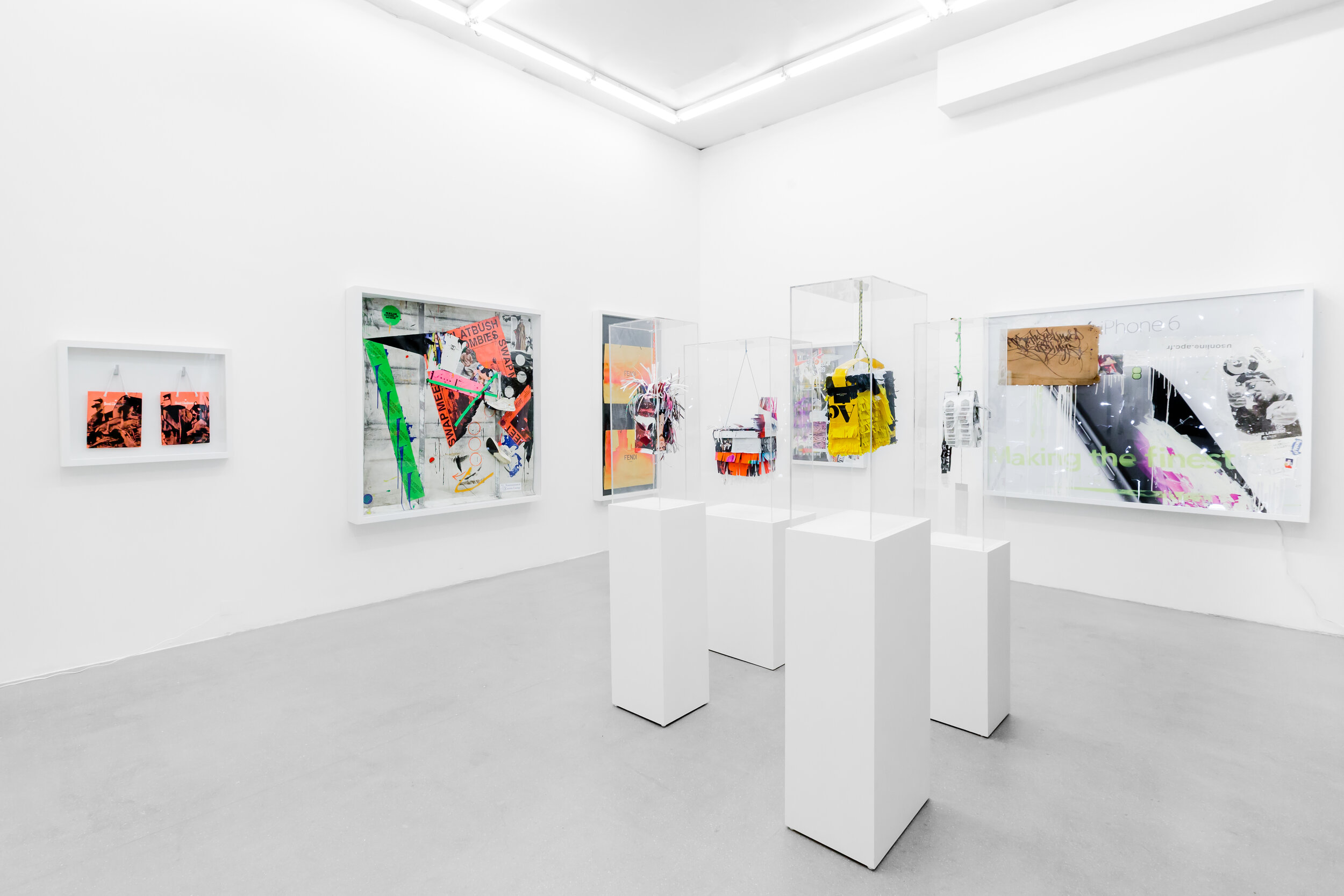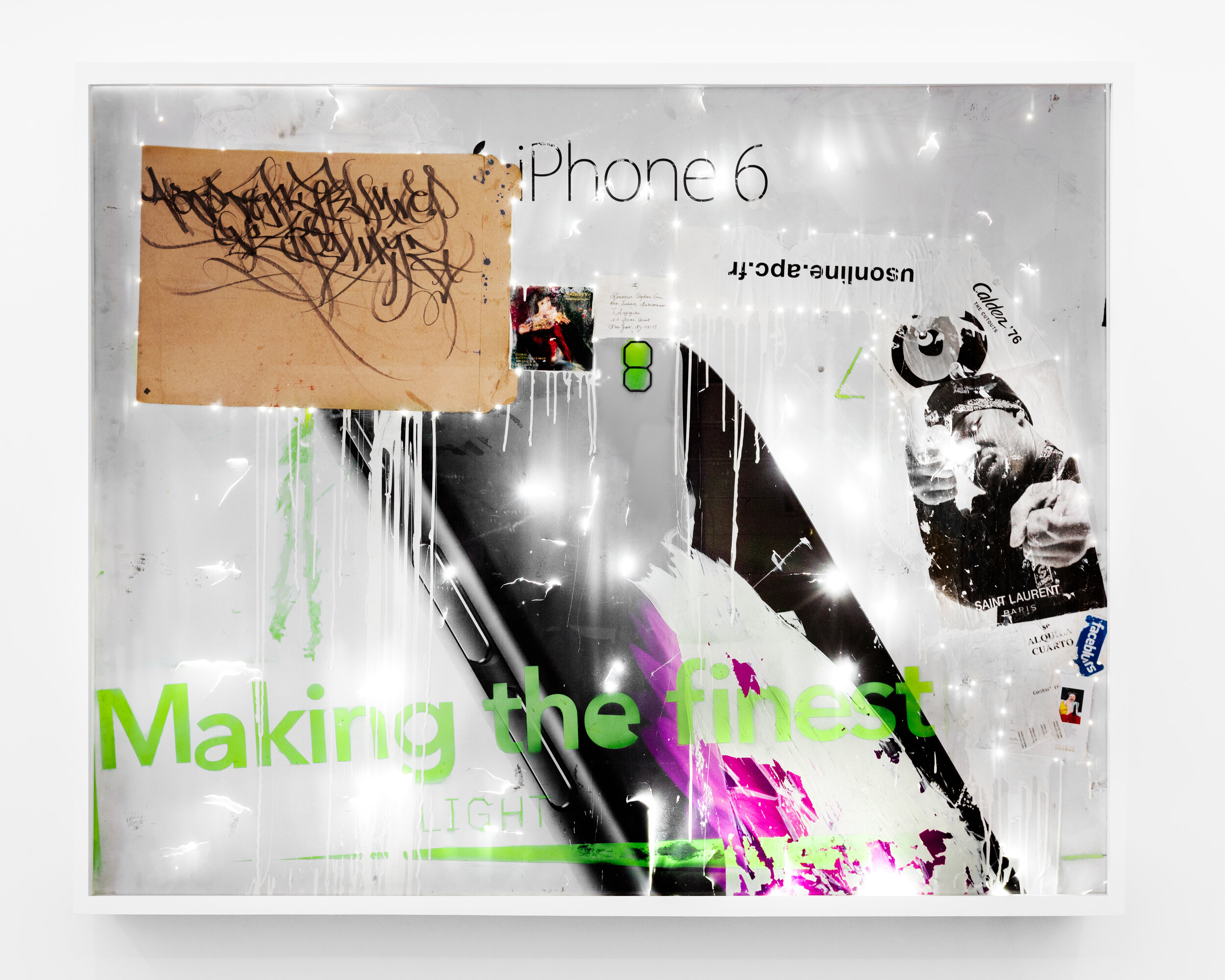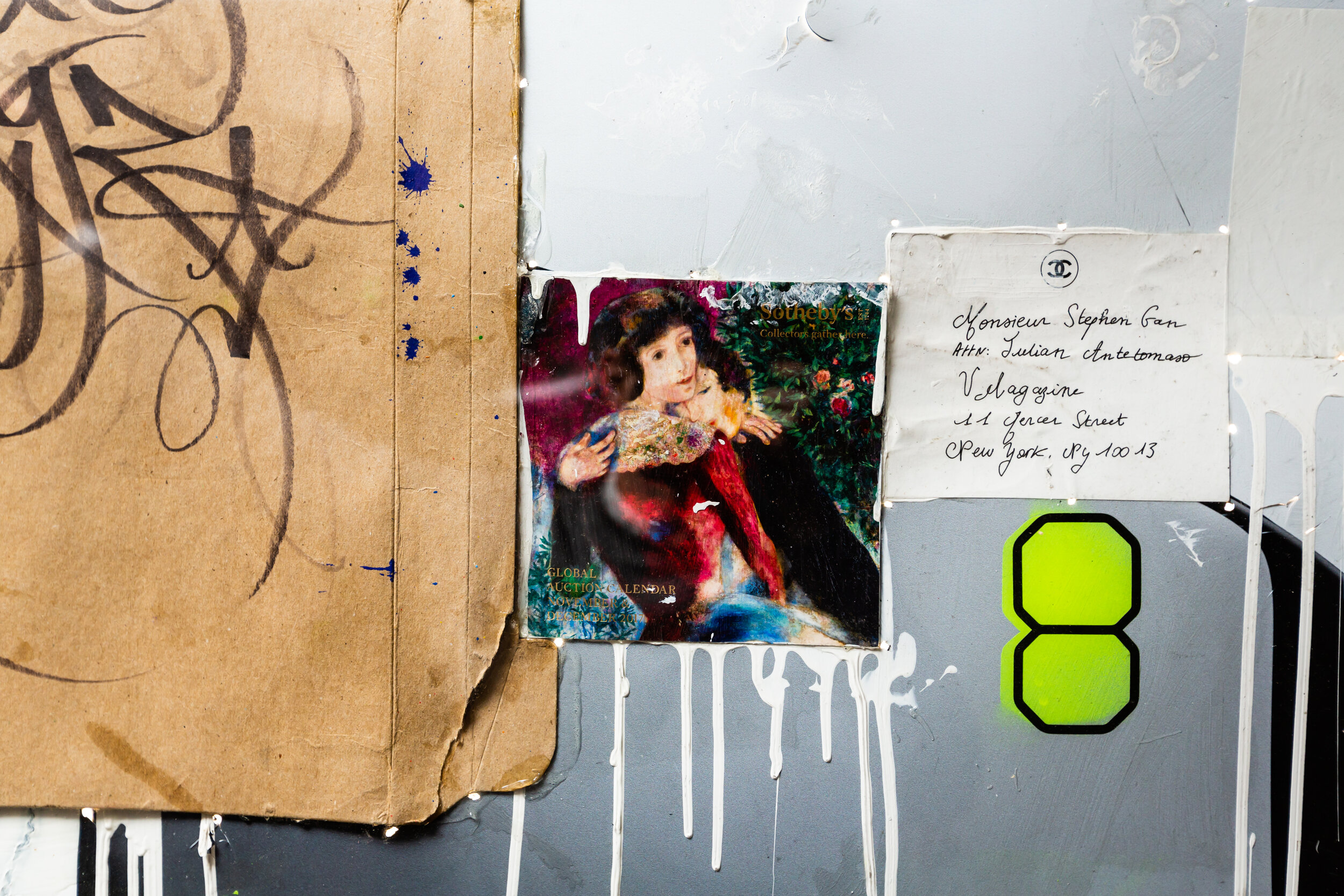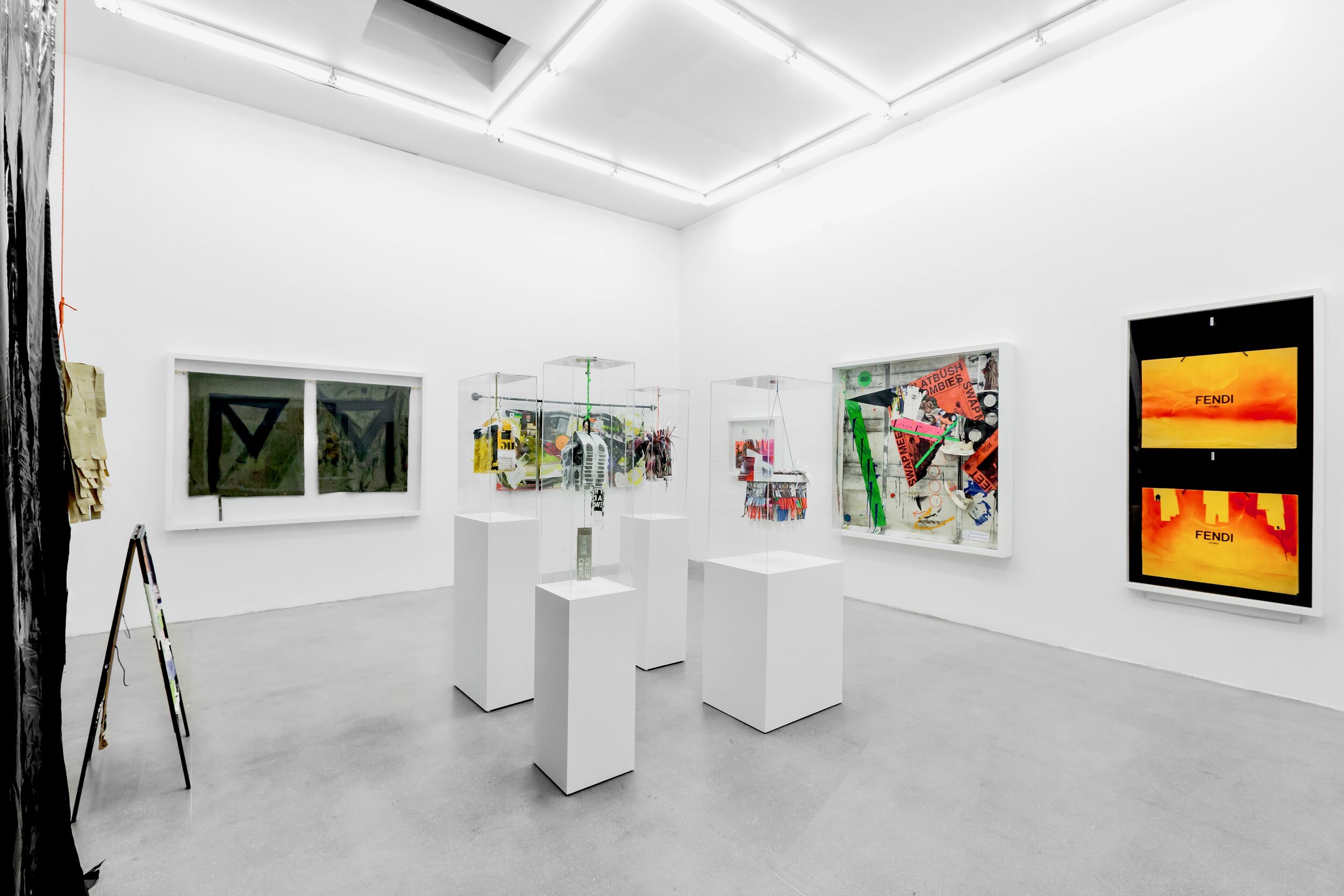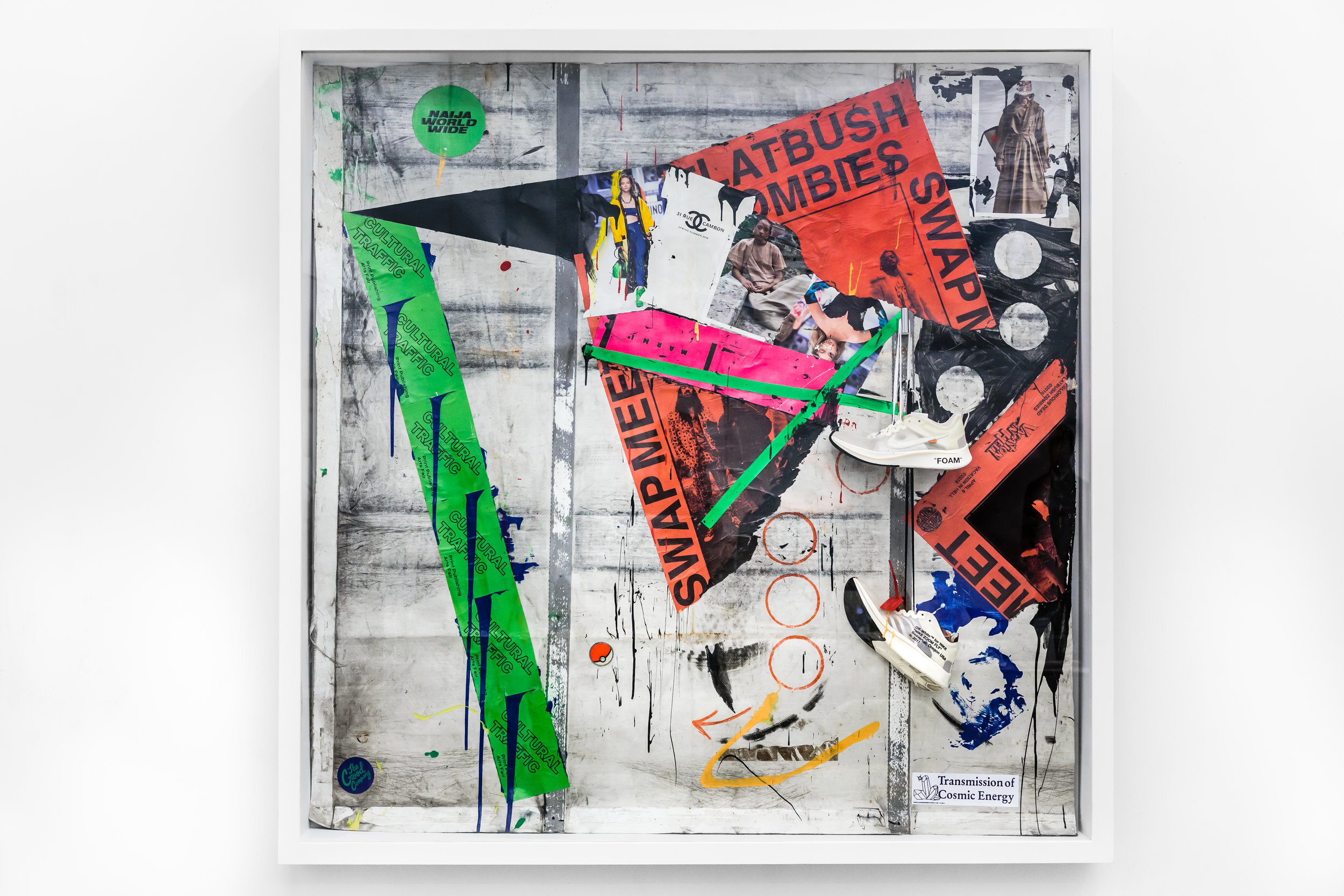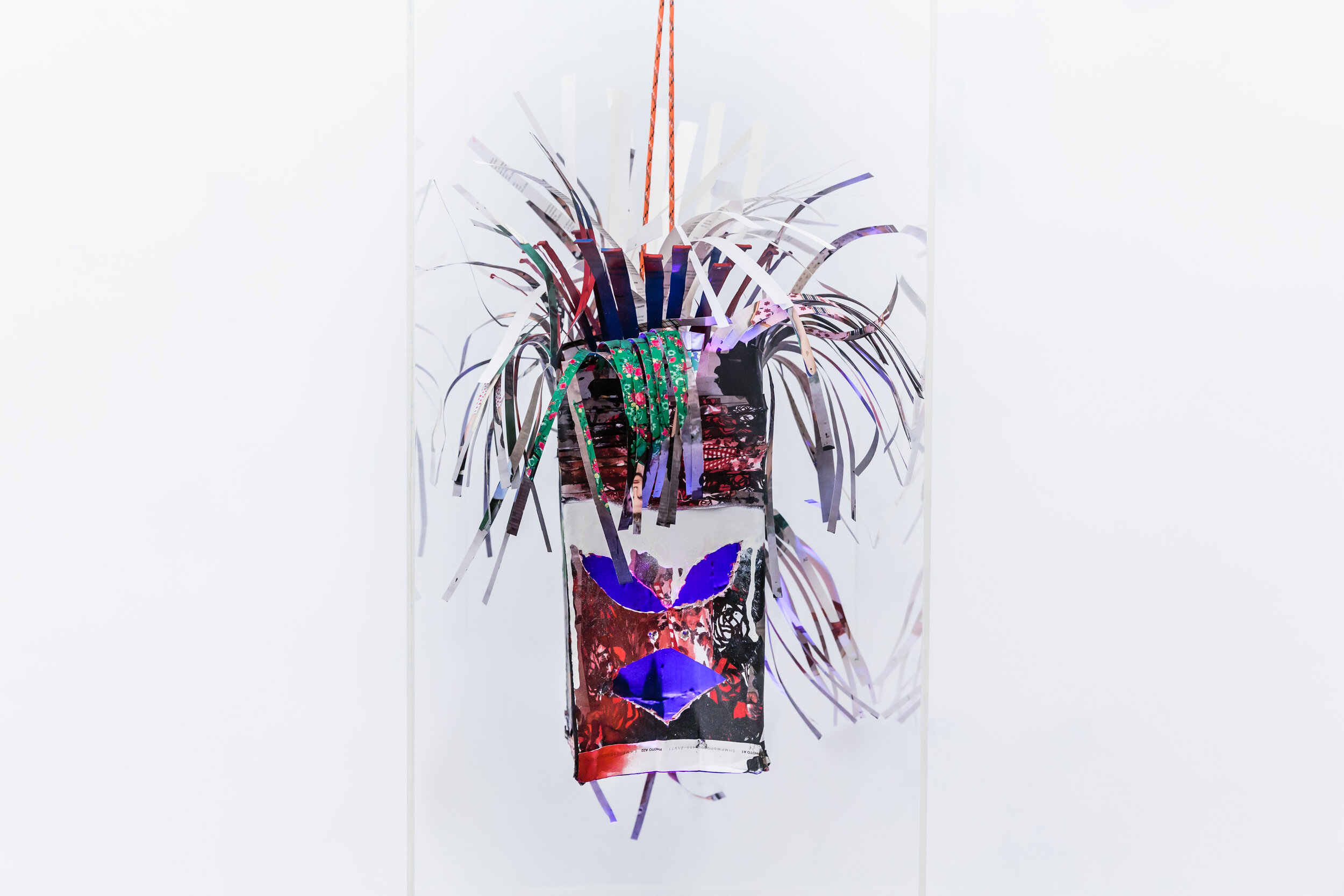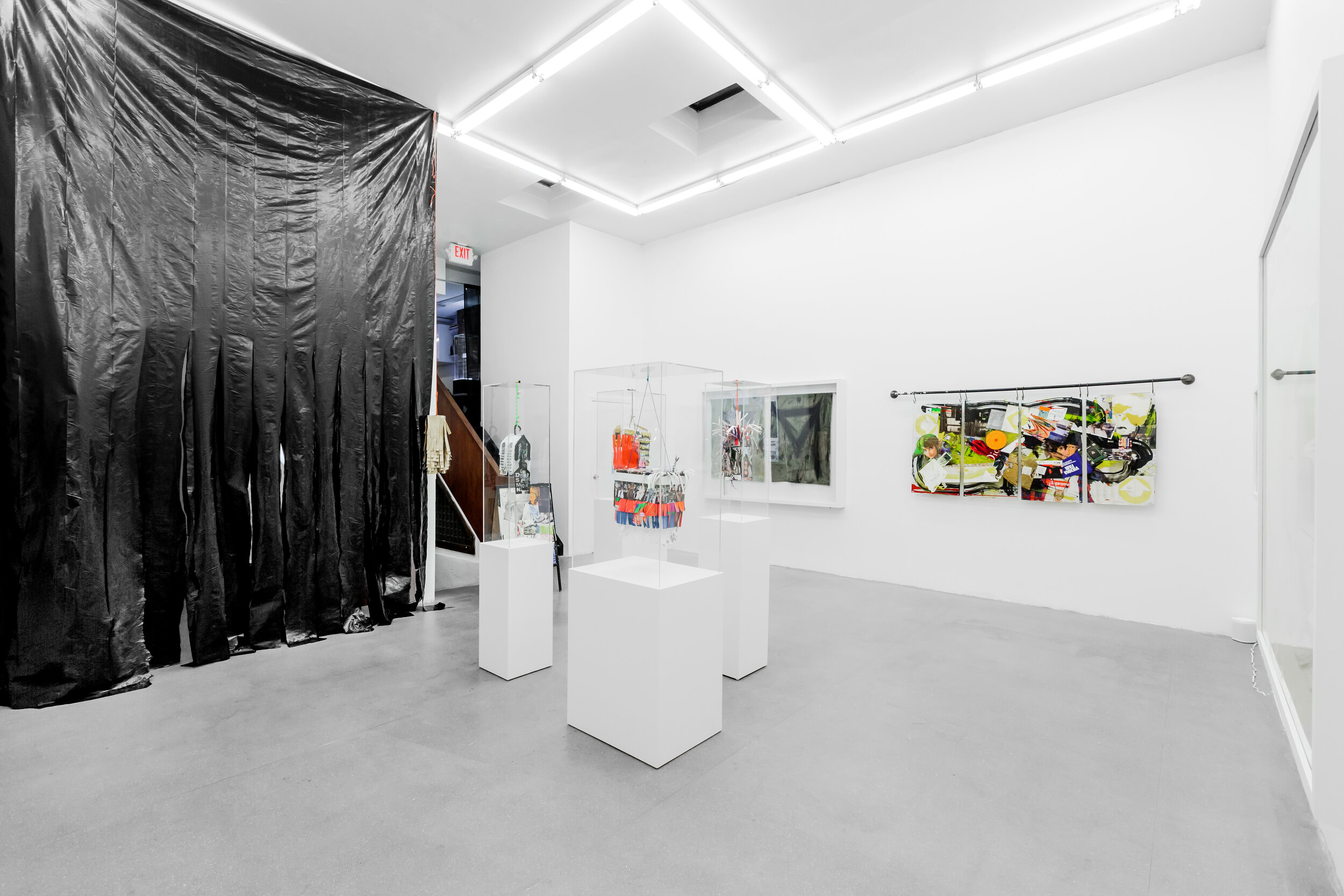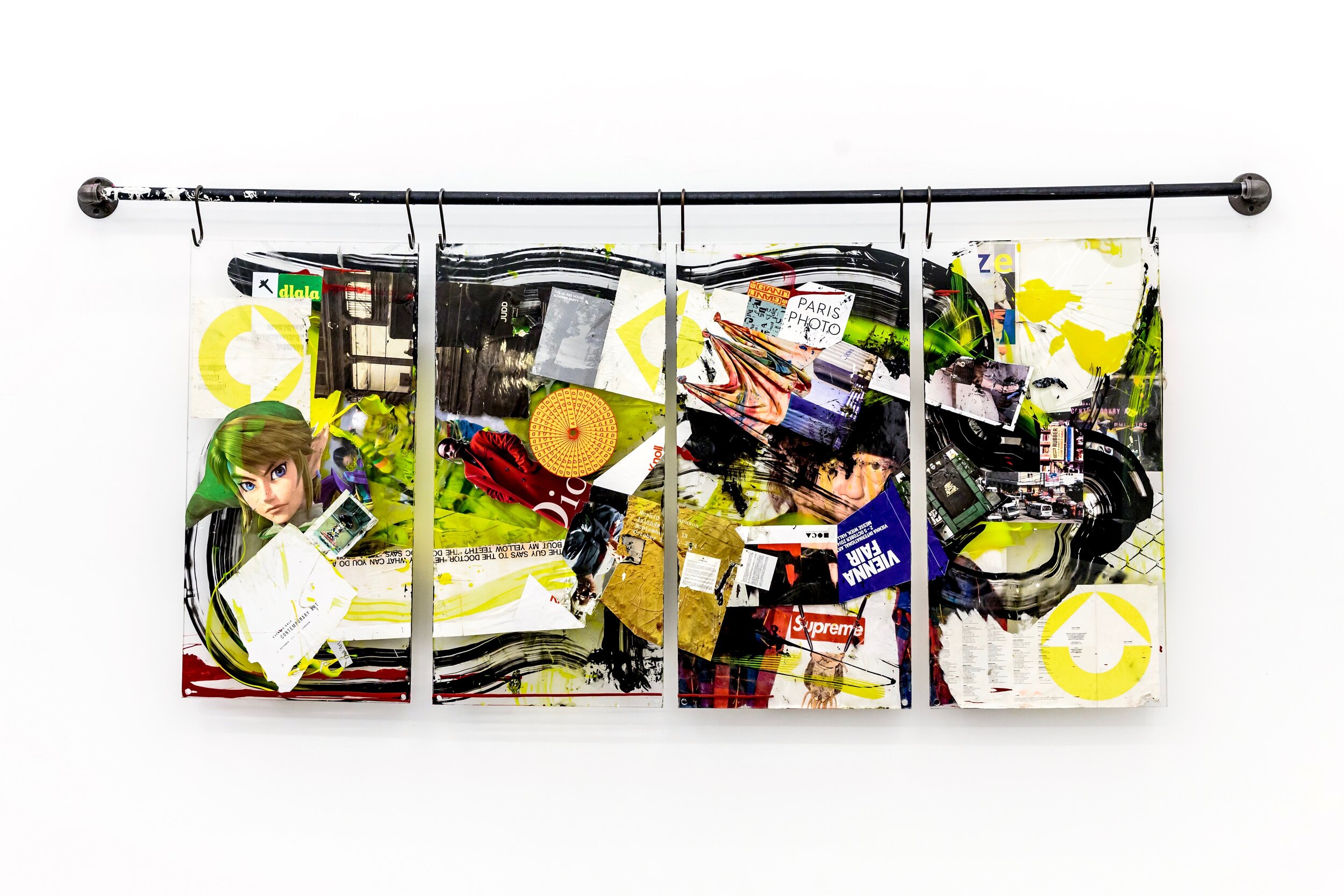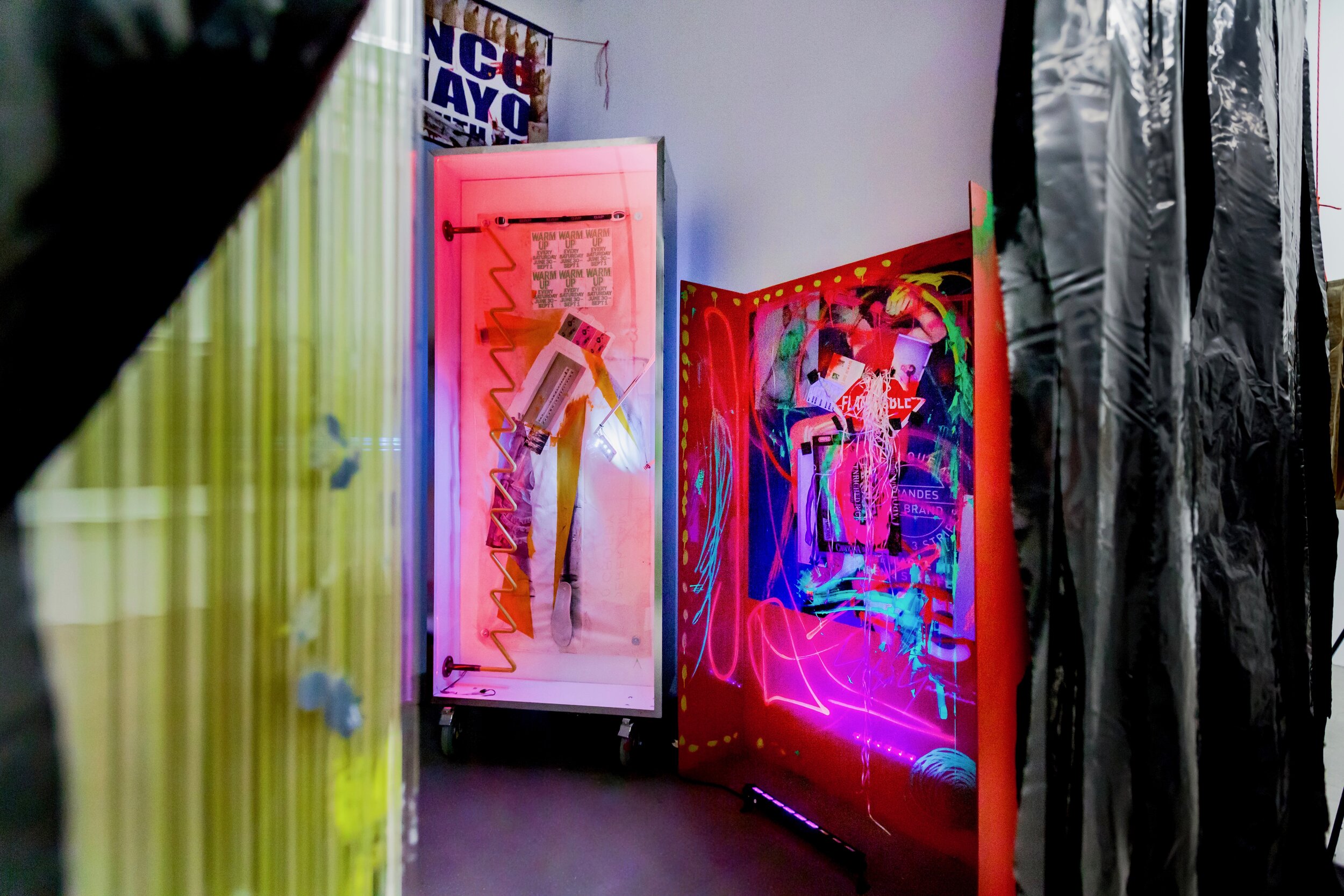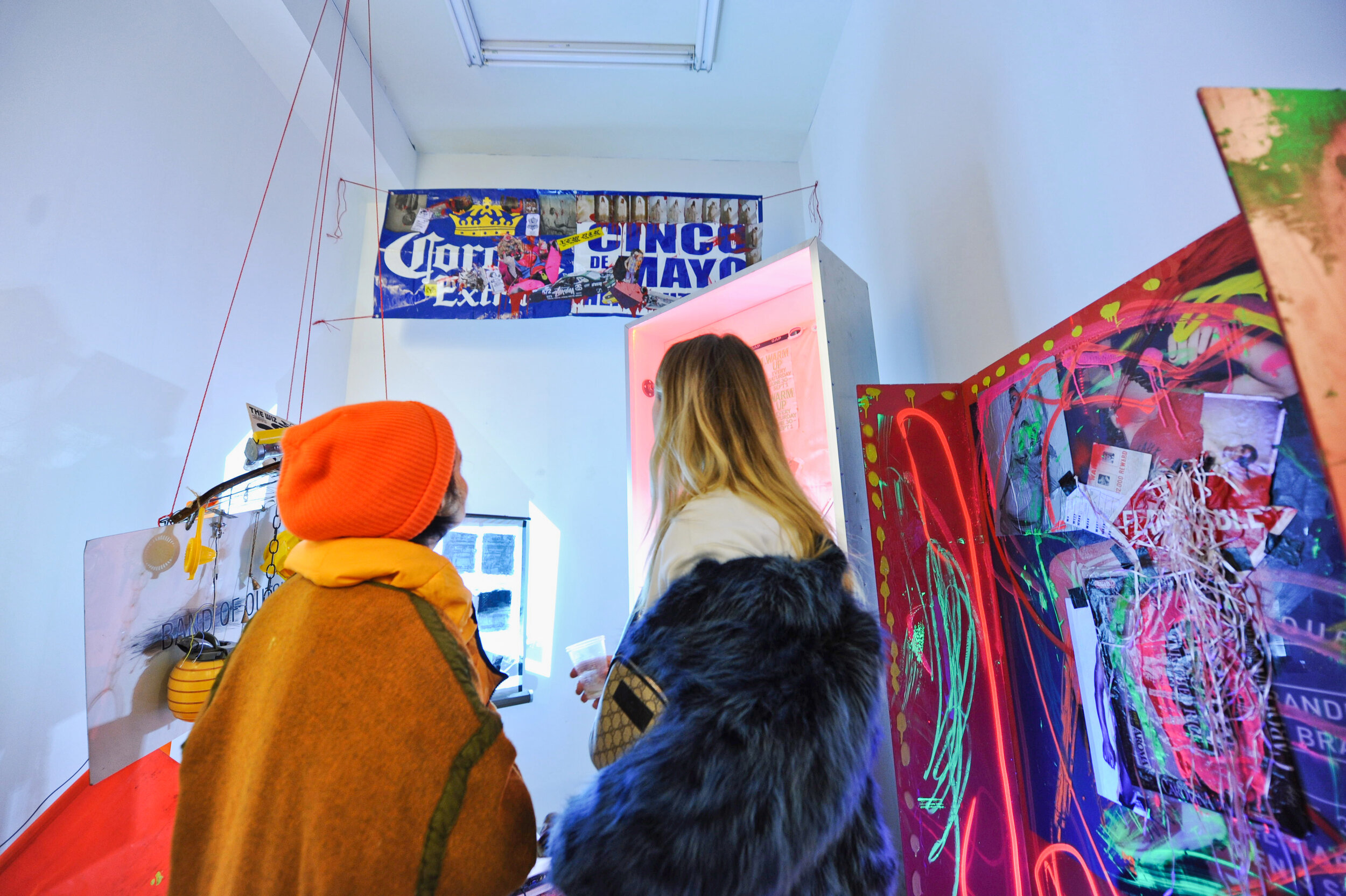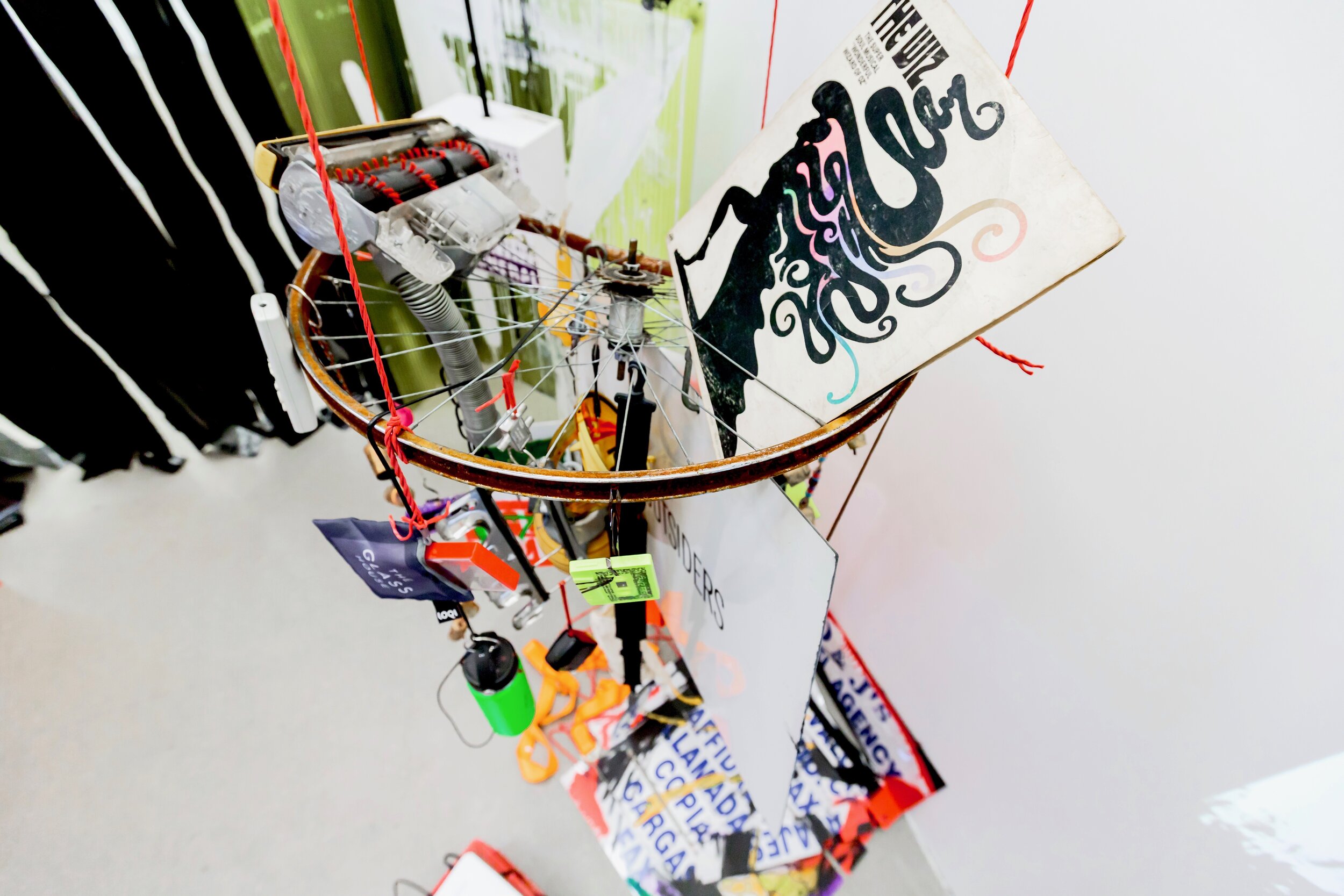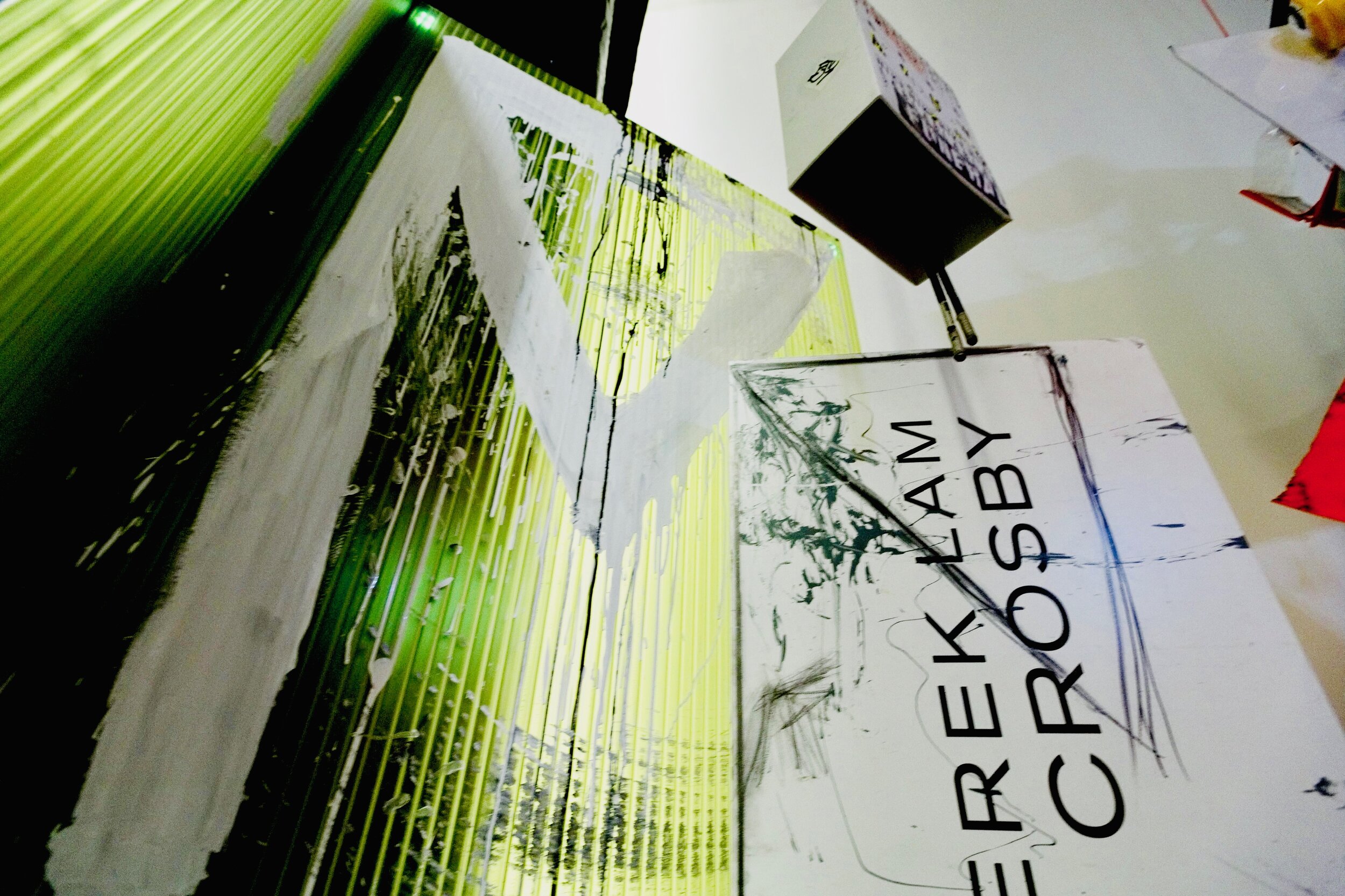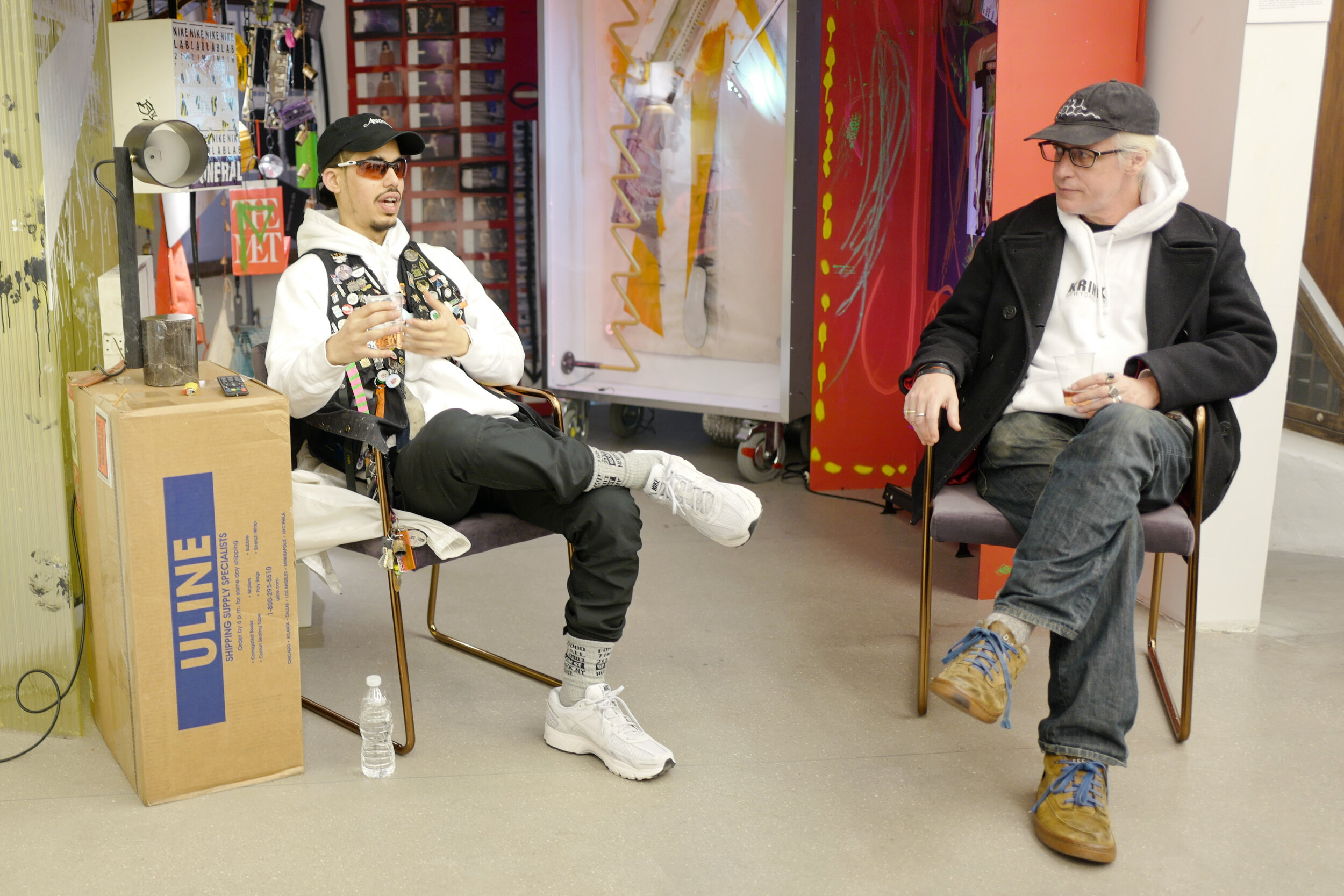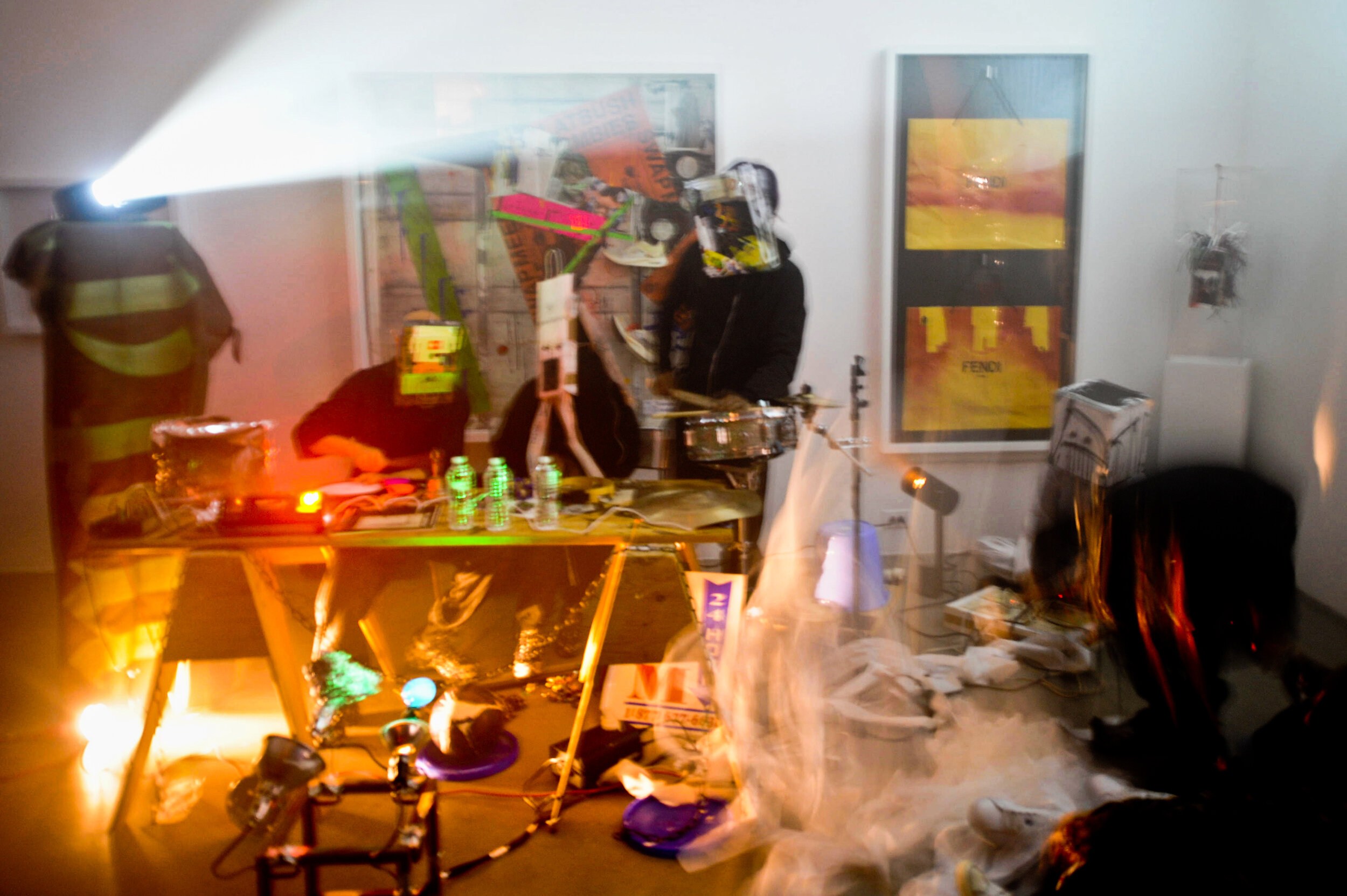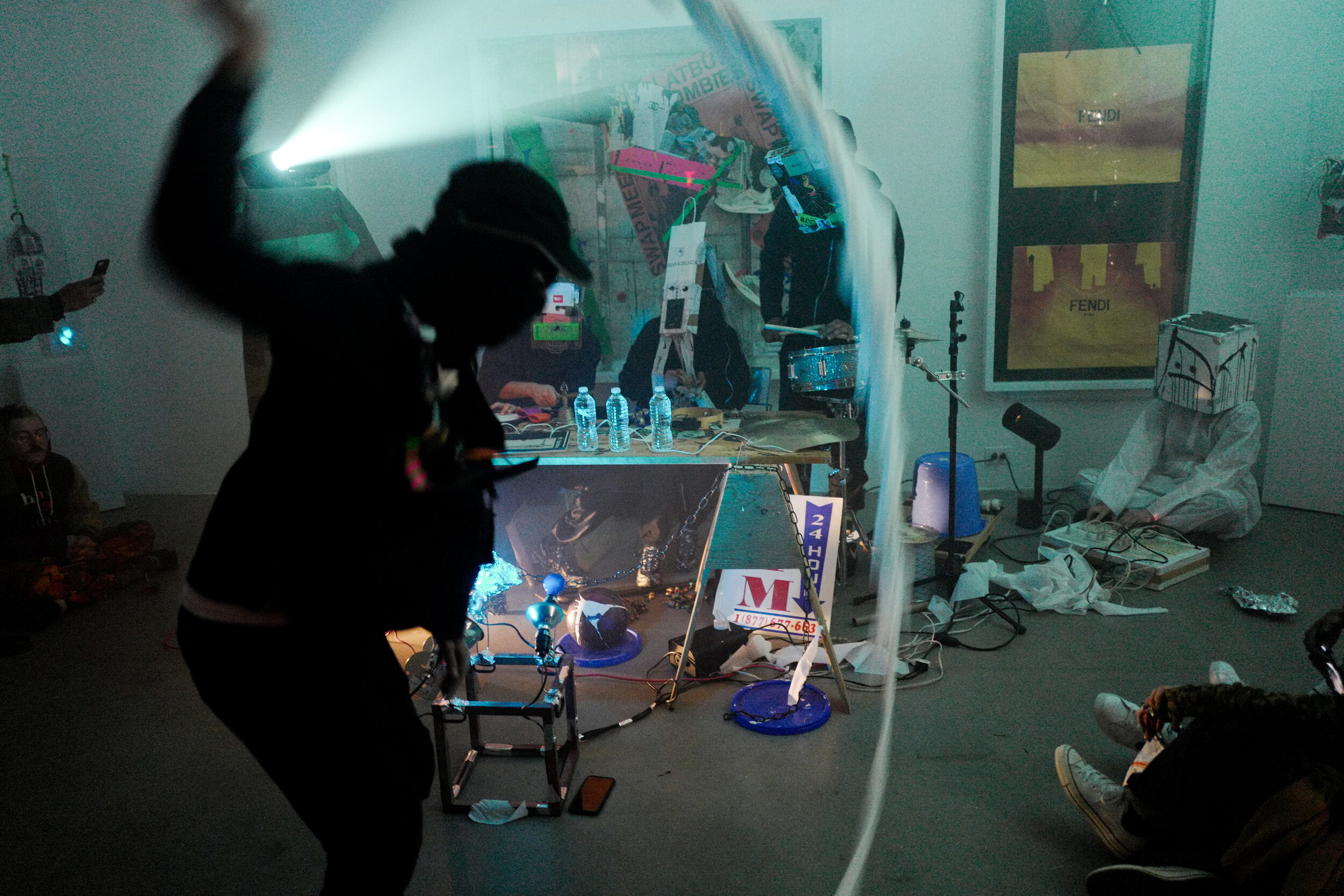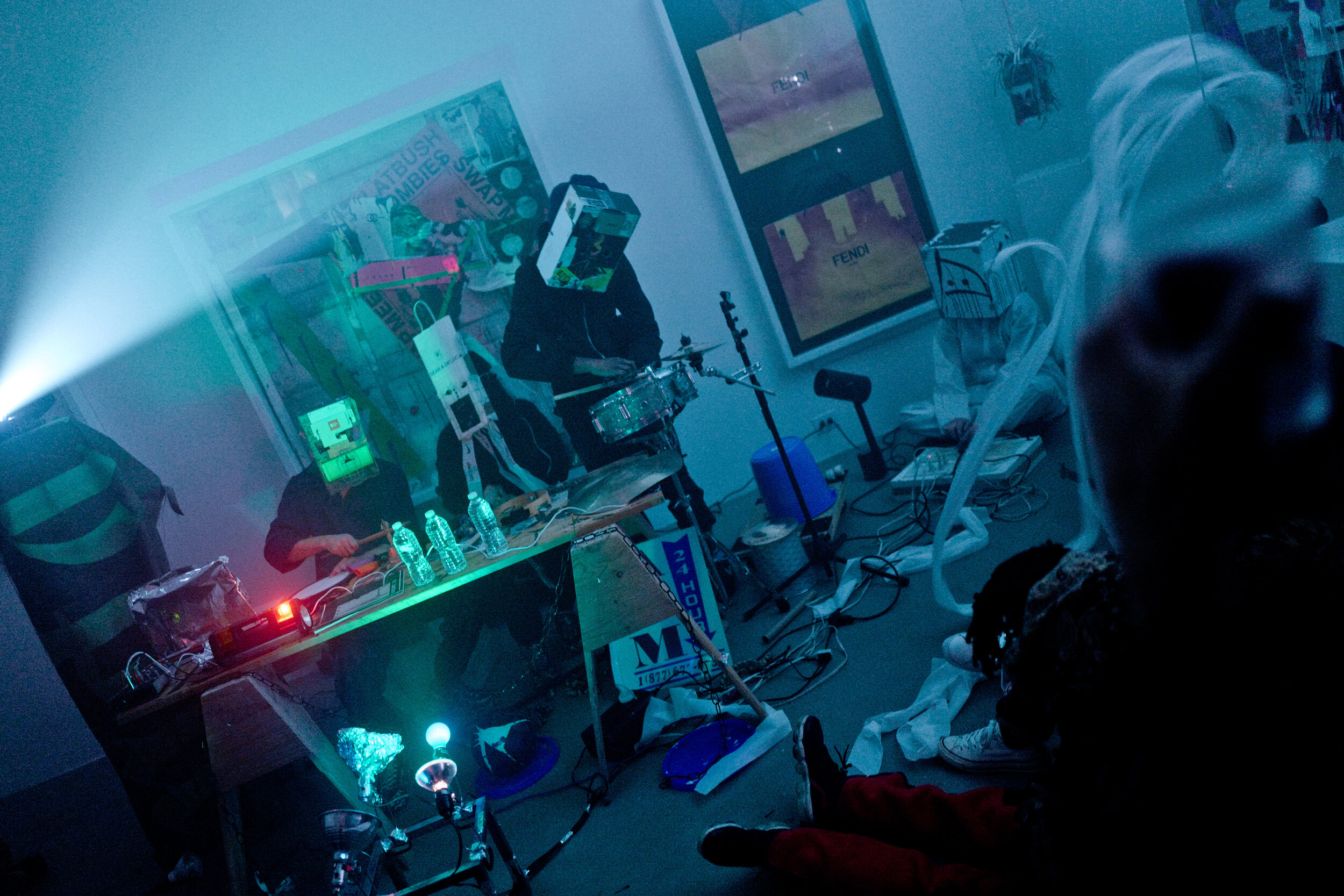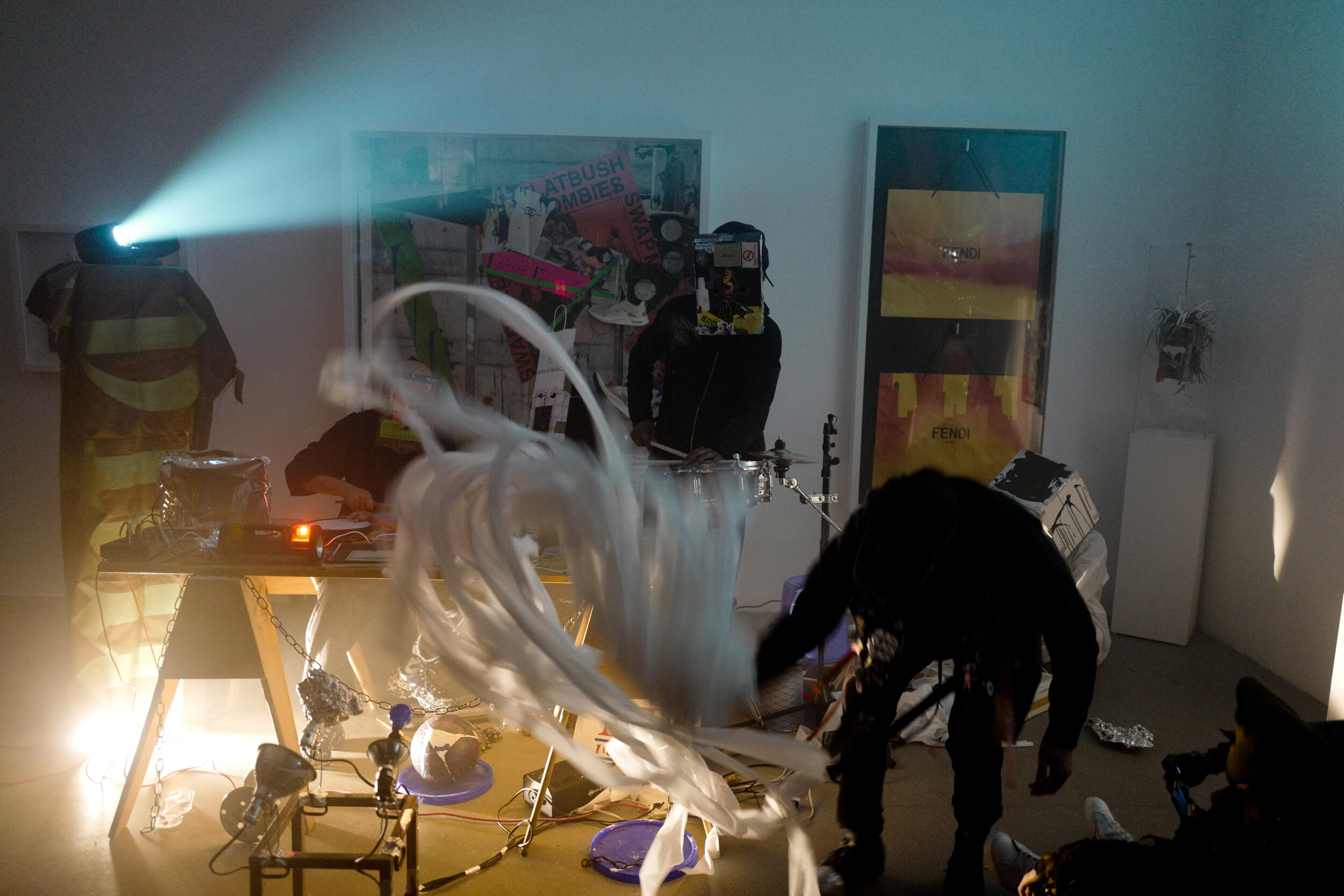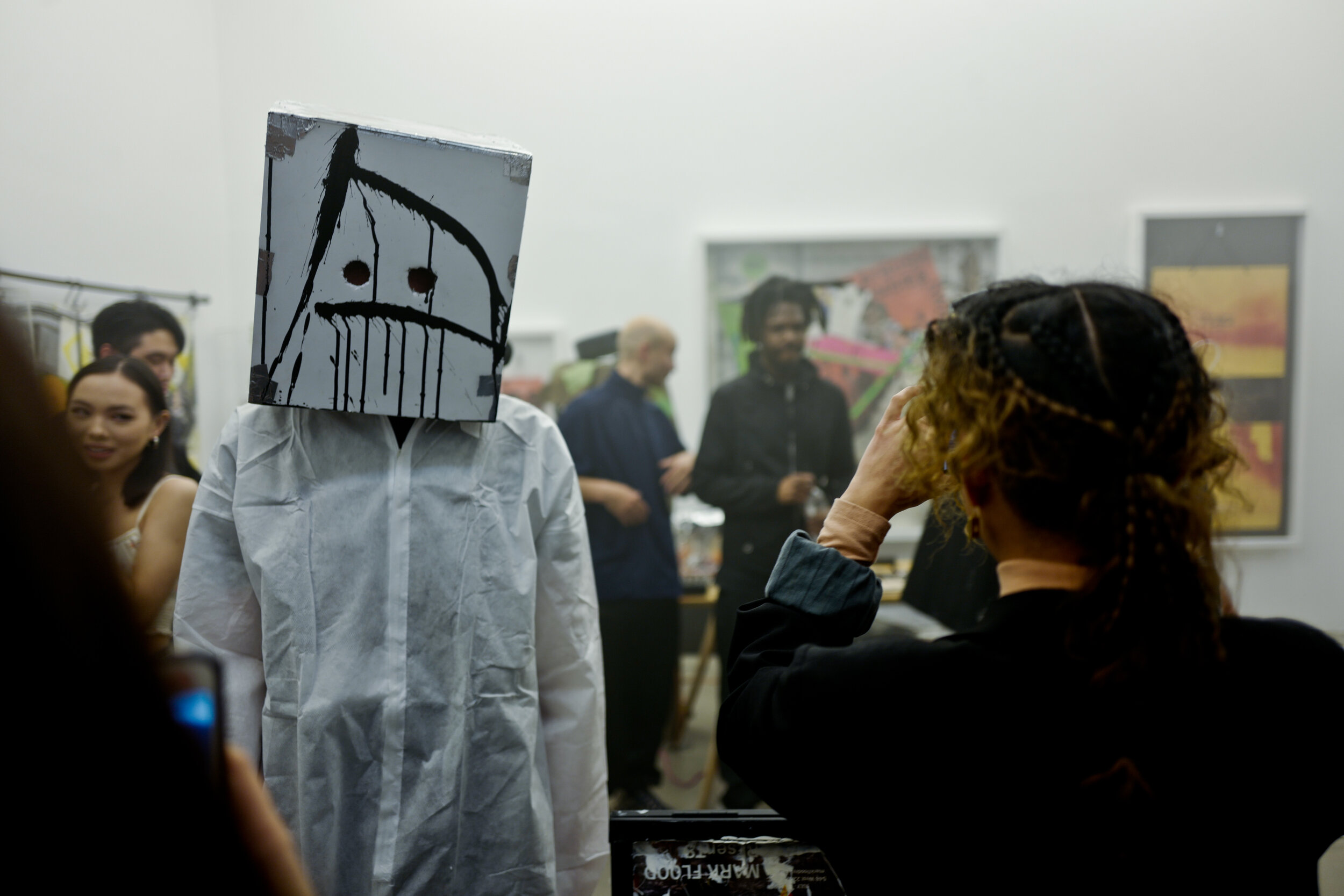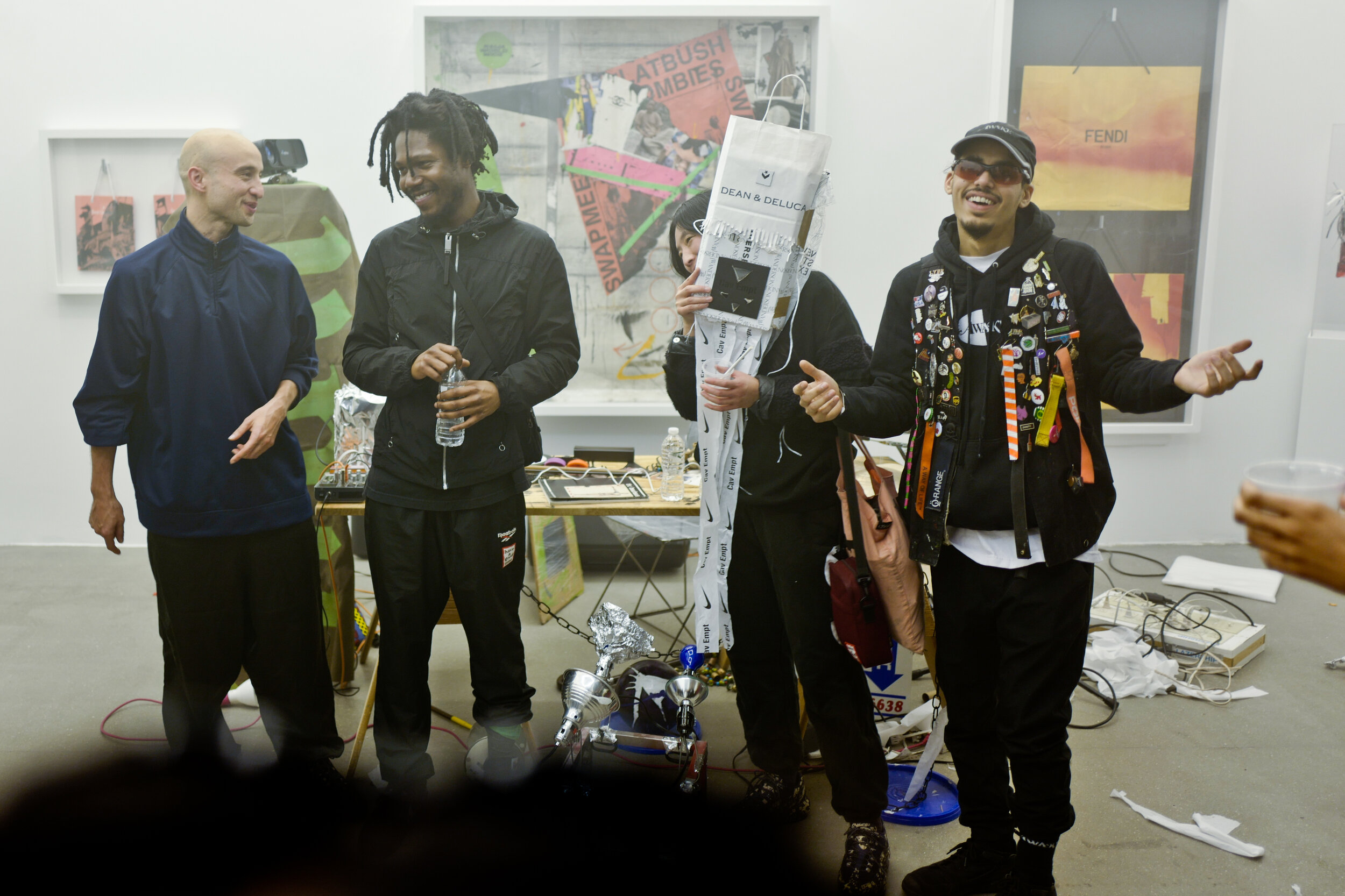DÉTOURNED
SOLO EXHIBITION BY MELVIN “GRAVE” GUZMAN
PRESS RELEASE
ABXY presents:
DÉTOURNED | Solo Exhibition by MELVIN “GRAVE” GUZMAN
EXHIBITION ON VIEW: THURSDAY, JANUARY 17th, 2019 – TUESDAY, MARCH 20th, 2019
Location: ABXY LES | 9 Clinton Street | New York, NY 10002
@grave_ | @abxyles | abxy.co | Artsy
FOR ALL PRESS INQUIRIES PLEASE CONTACT MELANIE KIMMELMAN
(New York, NY) ABXY presents Détourned a solo exhibition by Harlem-born artist MELVIN “GRAVE” GUZMAN. Détourned marks the artist’s second solo show with the gallery following A Grave New World (2018). The immersive installation at ABXY showcases a new collection of the artist’s monumental mixed media work as well as an eerie soundtrack, a short film featuring Guzman’s performance art, and a projection on display in an artist-designed theater within the gallery. The exhibition will be on view from January 17 – March 20, 2019. Exhibition essay by Carlo McCormick.
Détourned : (noun, from the French, “détournement”) an artwork resulting from the practice of appropriating or altering existing media artifacts in order to give them a new subversive meaning, often shifting the original meaning to one with revolutionary significance.
Known for his irreverent mixed media works, Guzman’s object-based artistic practice aptly connects with this avant-garde tradition. Working exclusively with found materials like torn magazine ads, shopping bags, posters, and ticket stubs once discarded by consumer culture, the artist creates sculptures and sprawling collaged tapestries, which satirize the psychological intensity of our image-driven world while highlighting the fluid relationship between environment and identity today.
Popularized in the 1960’s by Guy Debord and the Situationistes Intérnationales, the term “détournement,” (roughly translated meaning: high jacking, derailment, or overturning) is an artistic practice originally aimed at exposing political and corporate manipulation. Working with traditional advertising media, the Situationists modified existing logos and corporate messaging to create disruptive visual puns as a critique on mid-century Western culture.
With Détourned, Guzman picks up this tradition in the click-bait era of Digital Age. Works created on outdated iPhone ads and glowing subway billboards playfully break the consumerist trance of digital media. But unlike the finger pointing characteristic of the Situationists and their more militant creative descendants, Guzman’s work brings awareness to the effect of contemporary advertising on our own value systems. Through absurdist creations like luxury piñatas, the artist wakes us from our hypnosis to reveal the manufactured state of human desire today. Composed entirely of our branded waste, the works in this exhibition suggest that in order to fully wake ourselves from the spell, we must first spiritually *click* unsubscribe.
This exhibition includes paper-maché piñatas, simulated pinball machines, hand-painted flags, and doll-sized houses. Star-spangled in luxury logos, these objects invoke our sentimentality and brand-lust simultaneously in a combination of artistic gestures, which confound contemporary American conceptions of value. By resurrecting the refuse of consumer culture as his source material, Guzman juxtaposes the state of the planet to our obsession with luxury and celebrity, relating our conflicted relationship with the physical world to our illogical reverence of commercialism. Transforming the branded debris of capitalist society into fabrications of youthful, vintage pastimes, the artist subversively implies that our desires have long been artificially shaped by American media.
Looking on, the viewer soon realizes that each rebelliously droll plaything in Détourned engages in a world of retro representation – arcade games, piñatas, flags – all symbols, stand ins for the religious, fantastical, and civic worlds they respectively represent. Like the internet, these objects invite human interaction in a language that requires we subscribe to their symbolic significance. In this context, Guzman’s whimsically absurd constructions convey the vulnerability of blind faith, in imagined realms, in an empire of signs. Their preposterousness parodies the irrational fantasies contemporary media culture effects on our own ideas of beauty, value, truth and relevance.
Performance by Melvin “Grave” Guzman with collaborators Austin Williamson, Brian Close, Kiki Kudo, and Bryan Ellingson
In his seminal work, “The Society of the Spectacle,” (1968) Debord argued that in pursuit of accumulated wealth, capitalist society aims to alienate us from ourselves and our desires, and that “the spectacle” (mass entertainment, news, and advertising) had replaced the commodity as society’s mechanism to do so. The philosopher predicted that eventually, media would become so pervasive, we would not be able to distinguish between real life and its representation. Amidst a misinformation crisis, a time when we are judged less for the content of our character than of our Instagram feeds, when virtual social networks compromise the integrity of real elections, the works in this exhibition ask us to look again at what we might throw away and shine the neon glow of nostalgia on the past, before the commodity had been replaced by the spectacle, the object by its representation, reality by its virtual equivalent.
In re-appropriated pastiche, Guzman creates resounding layers of meaning within each work in Détourned. An ode to organized chaos, this hypnotic artistic language often obscures the viewer’s sense of time and place. The transporting works in this exhibition sentimentally suggest the importance what Debord called “lived time” retrieving our attention from the domain of the spectacle and returning to the world of human interaction. They serve as an omen for contemporary naivete surrounding the future psychological, political, and social consequences of media in the Digital Age. And like a fun house mirror, reflect the distorted image of our own false appetites in real time. In an effort to provoke the audience out of their complacency, with this exhibition, Guzman artistically transcends space and time to bring us something holy: an entirely recycled environment, where each work endeavors to reclaim the realization of dreams and the possibilities of a transformed life from the spiritual vacuum of contemporary capitalist media.
ADDITIONAL INFORMATION
THE PHANTOM
Like a hidden Micky, the phantom figure often appears in Guzman’s work. The artist first created the abstract character by chance during the execution of a performance art piece. The performance, which was inspired by an evening when the artist was stabbed in an uptown bar, featured Guzman acting as the hands of a clock, forming a large charcoal ring around him. As he created the ring, the artist simultaneously marked time by expressively slashing a scrap of Givenchy promotional material at his feet with the charcoal. The resulting (vaguely triangular) linear abstraction, now known as the phantom, has come to signify the presence of good and evil, dark and light, yin and yang when and wherever it emerges in the artist’s work. “The phantom was created when I got a second chance at life, so the phantom represents that first life,” says Guzman of his haunting signature, “But it’s still a part of me, it’s always with me. Like the good and the bad, you can’t know one without the other. The phantom is all about that kind of duality.” For more on the origin story of the phantom, see interview on the artist’s page (bottom).
“Guzman’s narrative, a story assembled in shards - entireties forever incomplete, conjuring like constellations where representation is a kind of connect the dots along the abject periphery of abstraction, is a shamanic storytelling befitting urban myth. His comic book reinvention of self, complete with a tragic-heroic alter ego The Phantom whose painful origin story based off a life-changing incident in which the artist had his face brutally sliced open in an uptown bar, is itself a cipher, a perpetual retracing of the cut, emblazoned as a sign reduced to a logo, Zorro’s mark reconstituted into the vernacular of graffiti, a tag whose very I was here presence connotes a converse gesture of absence.” Excerpted from exhibition essay by Carlo McCormick. Read full essay below.
SHORT FILM
Entitled “Future Phantom // Phantom Future,“ the short film displayed on the gallery’s upper level showcases a performance artwork created by Guzman in collaboration with close friends and fellow artists Bryan Ellingson and Austin Williamson of Onyx Collective. With a one-hundred-dollar budget, the crew used found materials like plastic sheeting, chains, hooks, studio lights, tools, bells, and clothing racks to create a set that would respond to their movements both optically and sonically. In the film, the group takes viewers on an audio-visual journey to the year 5096. Sporting artist-imagined hazmat suits in a dystopian representation of the future, the time travelers execute their mission: to create one of Guzman’s signature phantom forms among the ruins of human existence. “The phantom was inspired by a piece of performance art, so for this show, I wanted to create a piece of performance art in its honor. The phantom is all about those kinds of inversions,” says Guzman of the video. “For this project, individual vision and improvisation came together in a really beautiful way. The sound of our feet on the plastic was just as important as the sound of Grave applying paint to this piece of corrugated plastic with a dry wall trowel….or the sounds I made by playing my bell sculpture…which were just as important as the shadows it cast,” says Williamson, “Through our movements, musical instruments became part of the visual landscape and art making became part of the sonic landscape, and we were all really inspired by that.” The original audio from the performance was captured on a cassette tape Williamson found the morning of the performance on a Brooklyn sidewalk. That particular cassette will be on display in the gallery during the exhibition. A limited edition series of audio cassettes with edited recordings of the performance will soon be available for purchase at the gallery and through the ABXY Bookstore.
CREDITS: Future Phantom // Phantom Future
Shot and directed by Frantz “JR” Juin and Brian Close
Editing by Frantz “JR” Juin and Brian Close
Light design and sound engineering by Bryan Ellingson
Performance by Melvin “Grave” Guzman, Austin Williamson (Onyx Collective), and Bryan Ellingson.
Music by Melvin “Grave” Guzman, Austin Williamson and Bryan Ellingson
SCORE
Created by Brooklyn-born renaissance man, MELO-X, an eerie soundtrack accompanies the exhibition. “Over the last year or so, hanging out at ABXY, I’ve been watching Grave work, and recording the sounds of the studio….snippets of conversations, songs that were playing, the noises produced by his art making process in general…and remixing them with my App, Curate Alpha to create a score for the show,” says MELO-X of his creation, “By compiling materials from NYC’s streets, Grave’s work reflects certain truths about us as a society. But when you see a Guzman piece, it’s like you’re looking back on our time from the future. He creates this critical sense of temporal distance in the work. So when I was creating the music for the show, I really wanted it to sound like the radio station that would be playing in this imagined dystopian future… I wanted it to feel like a DJ sifting through sonic ideas, the way Grave sifts through his materials, looking for a piece of something that’s just right for that particular time and place.”
Producer Melo-X with artist Melvin Grave Guzman, ABXY Lower East Side, 2019
DÉTOURNED: EXHIBITION ESSAY
By Carlo McCormick
Across a landscape of desire where consumerism constitutes lifestyle and luxury in surfeit subsumes identity, there wanders a creative adventurer named Melvin “Grave” Guzman. A scavenger of our wasteful excess and an interlocutor of those discrete meanings that lay latent within our manic materialism, Guzman is watchful of our wishes and conscious of the cultural subconscious that compels the compulsions of acquisition. He understands the nature of our dream machine and moves through our dreams like an interloper whose interventions are at once a trespass, a theft and a rescue. His art, a tracing of his travels and examination of the traces strewn to the side of our perpetual distraction, is a saving grace, the best thing that can be said about all that is wrong at the moment.
Artist Melvin “Grave” Guzman and writer Carlo Mccormick, ABXY Gallery 2019
Much like the cargo cults that developed in the late 19th and early 20th century where less materially advanced cultures, encountering the detritus of the modern world, developed ritualistic practices around the foreign materials that washed up upon their worlds, Guzman’s retrieval and recombination of the shiny display baubles he gathers in his daily rounds of the great shopping mall that is now downtown Manhattan offers a kind of magical thinking, an alchemy of transmutation where the emptiness of a non-specific and unquenchable wanting is invested with personal and esoteric meanings. It is at once casual and relatively random yet also deliberate and definitive, built of his idiosyncratic mythologies and empowered through the modern ritual of performance art where the spontaneity of play and the inventiveness of imagination proffer a make-believe that makes belief. DIY and homemade no matter the inherent slickness of much of his found objects, the theatricality of process, captured in videos but also evident in the work itself, reveals and revels in the dual status of his art as not simply objects of contemplation but also as artifacts of a post-utilitarian purpose and as props in ongoing narrative.
Guzman’s narrative, a story assembled in shards- entireties forever incomplete, conjuring like constellations where representation is a kind of connect the dots along the abject periphery of abstraction, is a shamanic storytelling befitting urban myth. His comic book reinvention of self, complete with a tragic-heroic alter ego The Phantom whose painful origin story based off a life-changing incident in which the artist had his face brutally sliced open in an uptown bar, is itself a cipher, a perpetual retracing of the cut, emblazoned as a sign reduced to a logo, Zorro’s mark reconstituted into the vernacular of graffiti, a tag whose very I was here presence connotes a converse gesture of absence.
Guzman’s signature “phantom” tag (in green)
Guzman is everywhere in his work, just as he seems to be in the city itself, but it is an assembly of personae, the self infinitely split by some social schism, a phantom’s dissembling where the revelation is guised and coded, its truth but an allegorical fiction. And wherever or whenever the Phantom appears in Guzman’s art, he is intangible and ethereal, an echo or memory more than a physical being anymore, what the artist calls his life from the time he was born until the time he was scarred, something past tense yet present still, that knowledge going forward that life can be taken away at any moment. He tells us it is the flag for the survivors of our ongoing Armageddon, brought from his fallout shelter in Harlem and planted downtown where all things are bought and sold.
A century past, when the flotsam and jetsam of society first became a physical material and creative language in the arts through the post-war hysteria of Dada and figures like Schwitters, this art of refuse and refusal allowed the commonplace as something inherently wretched and anonymous, albeit spun into gold by the glory of modernism. With Grave’s dedication to the discarded however one gets no sense of the forlorn. His are not the lost mementos of our attics and dustbins but the found treasures of our commercial design aesthetics, collapsed and collaged as composite mediations of our hyper-mediated landscape. Built of the incidental, the elements themselves are far from accidental, each loaded with the artist’s keen sense of the attendant brands and stores that were their original source. Describing his assemblage as a way of “building narratives for the people,” what is uncanny is how for whatever randomness his art embraces there is always a discrete deliberateness in composition and content. “Everything is on purpose,” he tells us, “I like to make mistakes, but never by chance.”
This abiding sense that Guzman wanders, seemingly lost but always with an internal map of where he wants to get to, functions as a kind of frisson within his art, a method to the madness that invisibly directs his collaborations and guides even his most informal and spontaneous of gestures within the syntax of a populist democratic spirit of communication. And though I was fortunate to meet Grave first as an artist, it is as this wanderer that I more frequently encountered him, a post-modern flaneur of the 21st Century whose orbits through the madding crowd mark the distance between today’s city of the spectacle and the metropolitan entropy of yore, while echoing the intoxication of 19th Century flaneur swept up in the masses, as Baudelaire described in Crowds as “this ineffable orgy, this divine prostitution of the soul giving itself entire… to the unexpected as it comes along, to the stranger he passes.” Rather than merely some bewitched itinerant of the streets however, Grave strikes us as an urban commando whose engagement with the urban is far more critical than acquiescent. His art stems from the Situationist’s navigation of our consumerist spaces, be it the derive (or drift) by which this notion of the flaneur enters into a psychogeography of discovery, or their strategy of hijacking and redirecting signs, called detournment, from which Guzman takes the name for this exhibition. Discursive and without apparent direction, these travels mapped in Guzman’s art are nonetheless pointed and purposefully problematic, a record of wishful and wistful wondering written in the wry tones of self-reflexive identification.
Installation view | Détourned by Melvin Grave Guzman | ABXY Lower East Side, 2019




